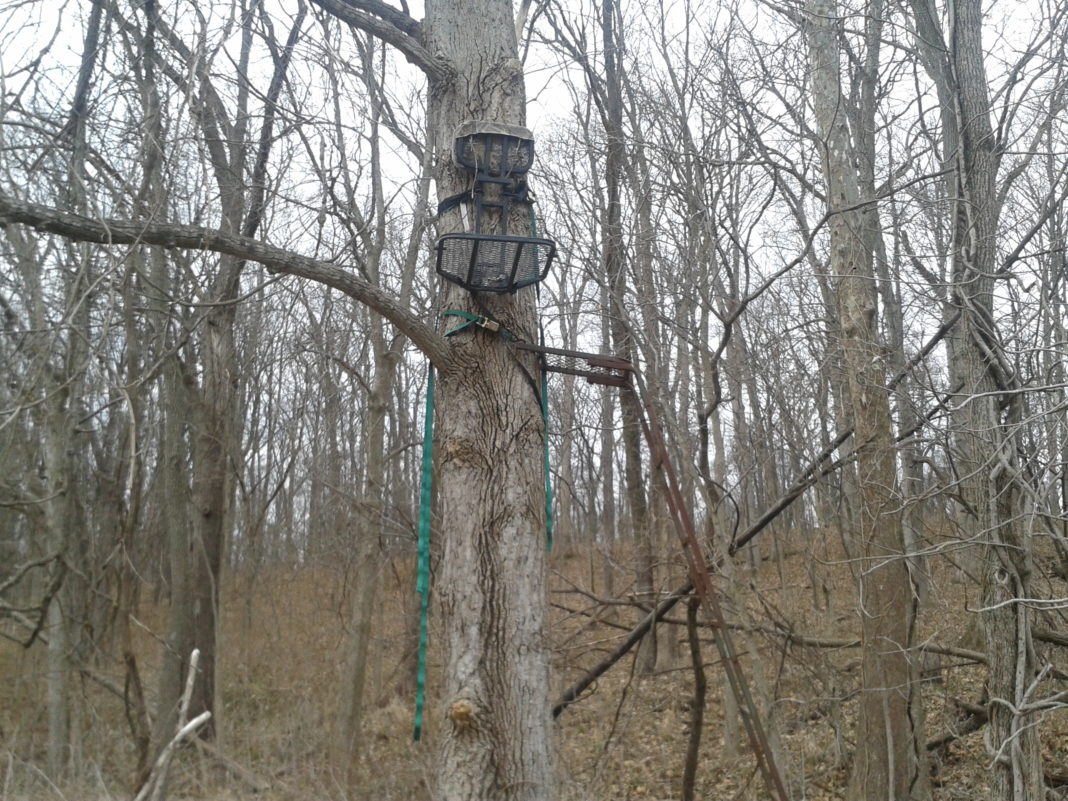Deciding where to hang stands early in the season can be difficult. Deer seem to be everywhere eating as much as they can from the grain fields and food plots. But, sometimes all of this food can cause a hunter to second-guess the best location for a tree stand. And, acorns can cause even more problems by the time season rolls around.
There are several things to take into consideration, but knowing where and what the deer are eating, and where the available water sources are located can be a big advantage. This can be accomplished through summer scouting regiments. Once you have these two things considered out, it is then time to start hanging your stands.
Thinking About Concealment
Early in the season when the trees are still full of leaves, hunters can get away with not climbing as high as they will have to later in the season.
Concealment ranks high on the priority list of most hunters when choosing a tree to hang a stand in when they do not plan on climbing very high. Hunters do not want to pick a tree that is naked of leaves and think they can get away with hunting twelve feet off the ground. A hunter might get lucky from time to time, but more times than not they will get busted before a deer ever presents a shot opportunity.
Another way to stay concealed is to pick a tree with multiple trunks. Not only will this provide that all-important cover, but it will also give you the hunter plenty of places to hang your gear.
If you cannot find a tree with cover, or multiple trunks, and you would rather not climb high all is not lost. Consider hanging your stand on the backside of the tree that is along the trail you want to hunt. Stand in your tree stand facing the tree keeping an eye on the trails in front of you. This will allow you to hide behind the tree above the deer while still giving you shot opportunities.
Find the Water
If the ground you are hunting has a water supply do not ignore it. While the weather is warm whitetails will get thirsty throughout the day. They will not only visit it at midday to quench their thirst, but also in the mornings as they return to their beds and again in the afternoon before they start to feed again. Place your stand downwind of the trail leading to the water supply. It does not take a lot of water to pull a deer in. Deer have been spotted drinking from a spring seep because that was the nearest water to their bedroom.
If there is a small stream running through your property, find where the deer are crossing it. Whitetails are an animal that likes to do things the easy way. Rather than cross where it is steep they will walk out of their way to find an easy crossing. Often, before they cross the creek they will usually pause for a few seconds giving you time to get a shot off.
Find the Mast
You might begin to notice that the deer are not going to the fields and food plots as early as they once were. You can probably blame acorns on that. The deer are still visiting the fields, but only after an appetizer of acorns. Deer prefer the sweet tasting white oak over the bitter red oaks. But, if the reds are dropping fruit and the whites are not, the deer will go to the red oaks. When both the white and red oaks are dropping fruit, the deer will devour the nuts from the white oaks before moving to the red oaks.
The best advice a hunter can get is to set up close to a hot oak that puts you within shooting range. Deer will mill around as they feed on the nuts. Always make sure the wind takes your scent away from the oaks. And as soon as oaks start dropping in good numbers, be ready. It might only last a couple of days, or it could last for weeks. However, your best chances will be the first or second day. A strong wind could cause all the acorns to fall in one night which could cause a feeding frenzy.
Apple and persimmon trees produce fruit that is well-liked by deer. If you have either tree on your property, hang a stand downwind. Once the trees start dropping their fruit, deer will walk long distances for the sweet treat.
Morning and Evening Considerations
For morning hunts, hang a stand on a trail between the food source and a known bedding area like a swamp or thick ravine. It is a good idea to stay within 50 yards from a food source. Any further and you run the risk of bumping the deer from the beds. This is a great tactic to sneak in without spooking deer off the food if any happen to be eating.
On an afternoon hunt you can often get away with hunting on the edge of food plot. Try to position your stand about 15 yards downwind from the entry trail or funnel. Unpressured whitetails will feel safe enough to enter to enter a food source with plenty of shooting light left.
Apple and persimmon trees produce fruit that is well-liked by deer. If you have either tree on your property, hang a stand downwind. Once the trees start dropping their fruit, deer will walk long distances for the sweet treat.



















![The Best Deer Camp Chili [VIDEO] Deer Chili Ingredients, Tomatoes, Chili Spices](/wp-content/uploads/2015/10/Deer-Chili-Deer-Camp-Recipe-218x150.jpg)
![How to Call Elk Early in the Season [VIDEO]](/wp-content/uploads/2016/08/byers003-218x150.jpg)




![Idiots Disturb Hunter: How Would You Have Handled It? [VIDEO]](/wp-content/uploads/2015/10/DSC00110-e1474487693878-100x70.jpg)
![Albino Buck Shocked to Shed His Antlers [VIDEO]](/wp-content/uploads/2015/10/AlbinoDeer-100x70.jpg)